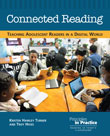
This month marks the publication of my fifth book, a co-authored work with Kristen Hawley Turner entitled Connected Reading: Teaching Adolescent Readers in a Digital World.
The research and writing process for this book took over two years, though it was well worth the effort. Combined, Kristen and I visited a dozen classrooms, interviewed nearly two dozen students, and surveyed 800 teens about their uses of digital reading devices. We discovered that reading was about much more than just the device; it remains, at the heart of it all, a conversation about words, stories, and ideas. Here is the official “blurb” from the back of the book:
As readers of all ages increasingly turn to the Internet and a variety of electronic devices for both informational and leisure reading, teachers need to reconsider not just who and what teens read but where and how they read as well. Having ready access to digital tools and texts doesn’t mean that middle and high school students are automatically thoughtful, adept readers. So how can we help adolescents become critical readers in a digital age?
Using NCTE’s policy research brief Reading Instruction for All Students as both guide and sounding board, experienced teacher-researchers Kristen Hawley Turner and Troy Hicks took their questions about adolescent reading practices to a dozen middle and high school classrooms. In this book, they report on their interviews and survey data from visits with hundreds of teens, which led to the development of their model of Connected Reading: “Digital tools, used mindfully, enable connections. Digital reading is connected reading.”
They argue that we must teach adolescents how to read digital texts effectively, not simply expect that teens can read them because they know how to use digital tools. Turner and Hicks offer practical tips by highlighting classroom practices that engage students in reading and thinking with both print and digital texts, thus encouraging reading instruction that reaches all students.
We summarize our model in this graphic, and hope that it sparks conversations about the nature of reading in a digital world.

Check out the first chapter on NCTE’s website as well as our companion wiki. We look forward to continued conversations about connected reading among teachers, parents, and, of course, our students.

One thought on “Introducing Connected Reading”
Comments are closed.